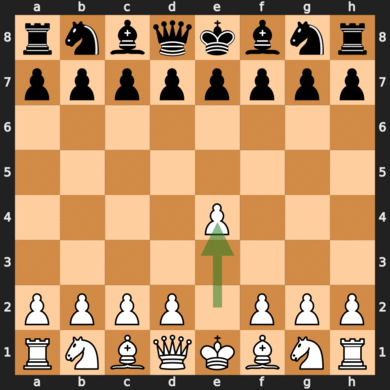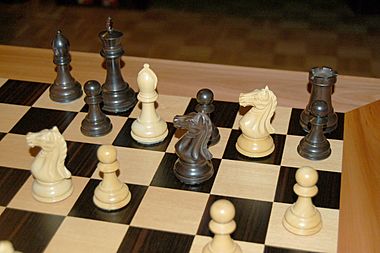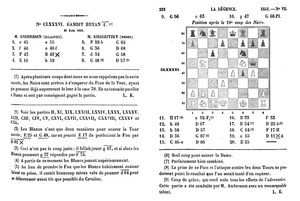Immortal Game facts for kids
The Immortal Game is a very famous chess game. It was played in 1851 by two great players, Adolf Anderssen and Lionel Kieseritzky. They played this game in London, while a big chess tournament was happening. However, the Immortal Game itself was just a friendly match, not part of the tournament.
Anderssen won the game in an amazing way. He let his opponent capture many of his pieces, including two rooks! This is called a sacrifice in chess. Even with fewer pieces, Anderssen managed to set up a powerful attack. He then used his remaining pieces to deliver a checkmate, winning the game.
Kieseritzky, even though he lost, was very impressed. He quickly shared the game with a French chess magazine. Later, in 1855, another player named Ernst Falkbeer called it "The Immortal Game" because it was so brilliant. It's still one of the most famous chess games ever played. Chess books often show it to teach players about exciting attacks and sacrifices.
How the Game Was Played
Adolf Anderssen was one of the best chess players of his time. Many people thought he was the strongest player in the world after he won the London 1851 tournament. Lionel Kieseritzky lived in France and taught chess. He was very good at playing against weaker players.
This game was informal, meaning it was just for fun during a break in the main tournament. Kieseritzky was so amazed by Anderssen's play that he sent the moves by telegraph to his chess club in Paris! A French chess magazine published the game in July 1851.
The Immortal Game is a great example of the "romantic" style of chess from the 1800s. In this style, players loved to attack quickly and make bold sacrifices. They didn't worry too much about losing pieces if it led to a strong attack. These games are often very exciting to watch, even if some moves aren't perfect by today's standards.
In this game, Anderssen won even after giving up a bishop, both of his rooks, and his queen! Kieseritzky only lost three pawns. Anderssen showed a similar attacking style in another famous game called the Evergreen Game.
After the game, Kieseritzky sent the moves to La Régence, a French chess magazine he helped to edit. The magazine published the game in 1851. They used an older, less common way of writing down chess moves.
The game has been printed many times since then. Sometimes, different versions have slight changes in the order of moves.
The Immortal Game: Move by Move
Here's how the famous Immortal Game unfolded:
White: Adolf Anderssen Black: Lionel Kieseritzky Opening: King's Gambit Accepted: Bishop's Gambit, Bryan Countergambit (ECO C33)
1. e4 e5 2. f4
- This is the King's Gambit. White offers a pawn to quickly bring out their pieces. This was a very popular way to start games in the 1800s.
2... exf4 3. Bc4
- This move brings out White's bishop. Black can check the king here, but White plans to attack Black's queen later.
3... Qh4+ 4. Kf1 b5?! (diagram)
- This is a risky move by Black called the Bryan Countergambit. Most players today don't think it's the best move.
| a | b | c | d | e | f | g | h | ||
| 8 |

|
8 | |||||||
| 7 | 7 | ||||||||
| 6 | 6 | ||||||||
| 5 | 5 | ||||||||
| 4 | 4 | ||||||||
| 3 | 3 | ||||||||
| 2 | 2 | ||||||||
| 1 | 1 | ||||||||
| a | b | c | d | e | f | g | h | ||
5. Bxb5 Nf6 6. Nf3
- White develops a knight. This move also attacks Black's queen, forcing it to move.
6... Qh6 7. d3
- White strengthens the middle of the board, called the centre.
7... Nh5
- Black moves a knight to the edge of the board. Knights are usually weaker on the edge.
8. Nh4 Qg5
- Black's queen moves again.
9. Nf5 c6
- Black attacks White's bishop.
| a | b | c | d | e | f | g | h | ||
| 8 |

|
8 | |||||||
| 7 | 7 | ||||||||
| 6 | 6 | ||||||||
| 5 | 5 | ||||||||
| 4 | 4 | ||||||||
| 3 | 3 | ||||||||
| 2 | 2 | ||||||||
| 1 | 1 | ||||||||
| a | b | c | d | e | f | g | h | ||
10. g4? Nf6 11. Rg1! (diagram)
- White offers to sacrifice a piece here. If Black takes it, their queen will be trapped.
11... cxb5?
- This was a big mistake by Black. Black gains a piece, but White gets a huge advantage in developing their pieces for an attack.
12. h4!
- White's pawn attacks Black's queen, which is protected by White's knight.
12... Qg6 13. h5 Qg5 14. Qf3
- White now has two threats:
- White's bishop can capture Black's pawn at f4, trapping Black's queen.
- White's pawn can move to e5, attacking Black's knight and opening a path for White's queen to attack Black's rook.
14... Ng8
- Black moves the knight back, but this makes Black's position even worse. White now controls most of the board.
15. Bxf4 Qf6 16. Nc3 Bc5
- Black develops a bishop, which also attacks White's rook.
17. Nd5
- White responds with a counterattack! This move threatens Black's queen and also a fork on Black's king and rook.
| a | b | c | d | e | f | g | h | ||
| 8 |

|
8 | |||||||
| 7 | 7 | ||||||||
| 6 | 6 | ||||||||
| 5 | 5 | ||||||||
| 4 | 4 | ||||||||
| 3 | 3 | ||||||||
| 2 | 2 | ||||||||
| 1 | 1 | ||||||||
| a | b | c | d | e | f | g | h | ||
17... Qxb2 (diagram)
- Black captures a pawn and threatens White's rook.
18. Bd6!
- This is an amazing move! White offers to sacrifice both of their rooks. This move helps White's attack by moving Black's queen away from a key diagonal.
18... Bxg1?
- Black captures a rook. This move is still winning for White, but it makes the game very complicated.
19. e5!
- White sacrifices another rook! More importantly, this move blocks Black's queen from helping to defend the king. White now threatens checkmate in two moves.
19... Qxa1+ 20. Ke2
- At this point, Black's attack has stopped. Black has many pieces, but they can't attack White's king right away. White, however, is ready to deliver checkmate. Some sources say Kieseritzky gave up here. Others say the final moves were played out.
20... Na6
- Black tries to defend by moving the knight to cover a key square.
| a | b | c | d | e | f | g | h | ||
| 8 |

|
8 | |||||||
| 7 | 7 | ||||||||
| 6 | 6 | ||||||||
| 5 | 5 | ||||||||
| 4 | 4 | ||||||||
| 3 | 3 | ||||||||
| 2 | 2 | ||||||||
| 1 | 1 | ||||||||
| a | b | c | d | e | f | g | h | ||
21. Nxg7+ Kd8 22. Qf6+! (diagram)
- White sacrifices the queen! This forces Black to capture the queen, which opens up the path for checkmate.
22... Nxf6 23. Be7# 1–0
- At the end, Black has many more pieces than White (a queen, two rooks, and a bishop). But these pieces don't help Black. White used only two knights and a bishop to force checkmate. This is why it's called the Immortal Game!
See also
 In Spanish: Inmortal (partida de ajedrez) para niños
In Spanish: Inmortal (partida de ajedrez) para niños
- Evergreen Game – another famous game won by Anderssen
- Kasparov's Immortal
- List of chess games




